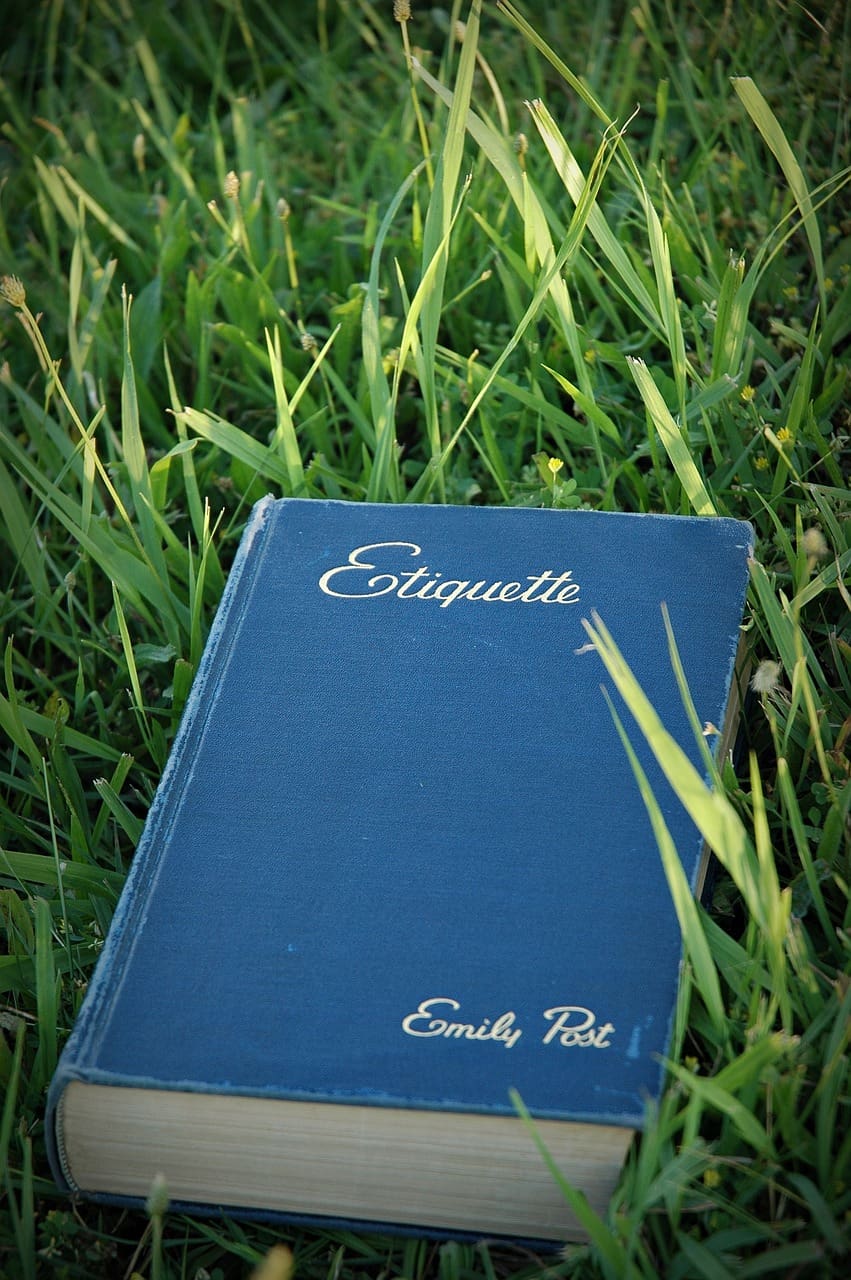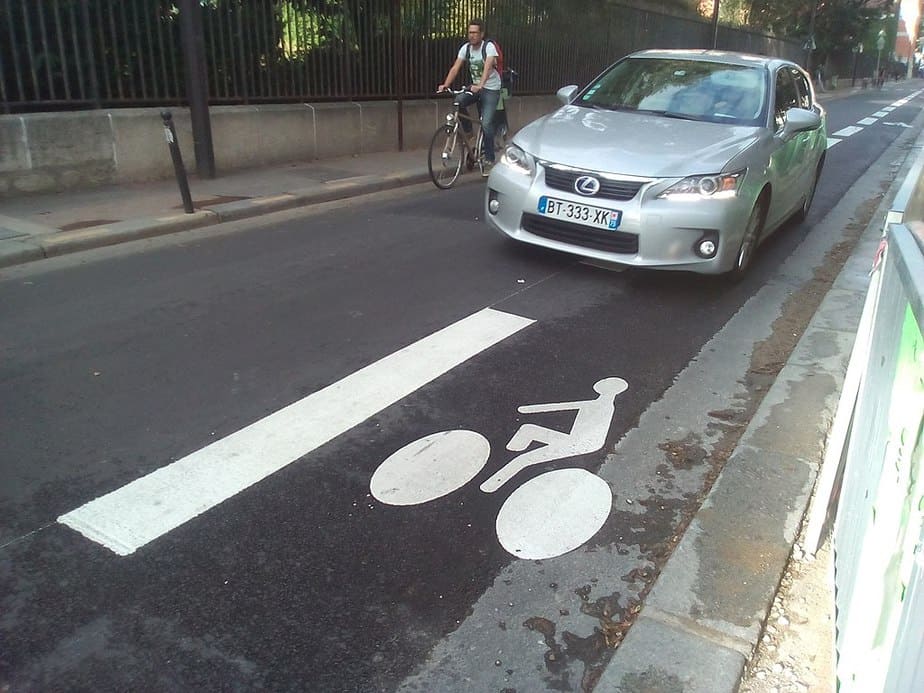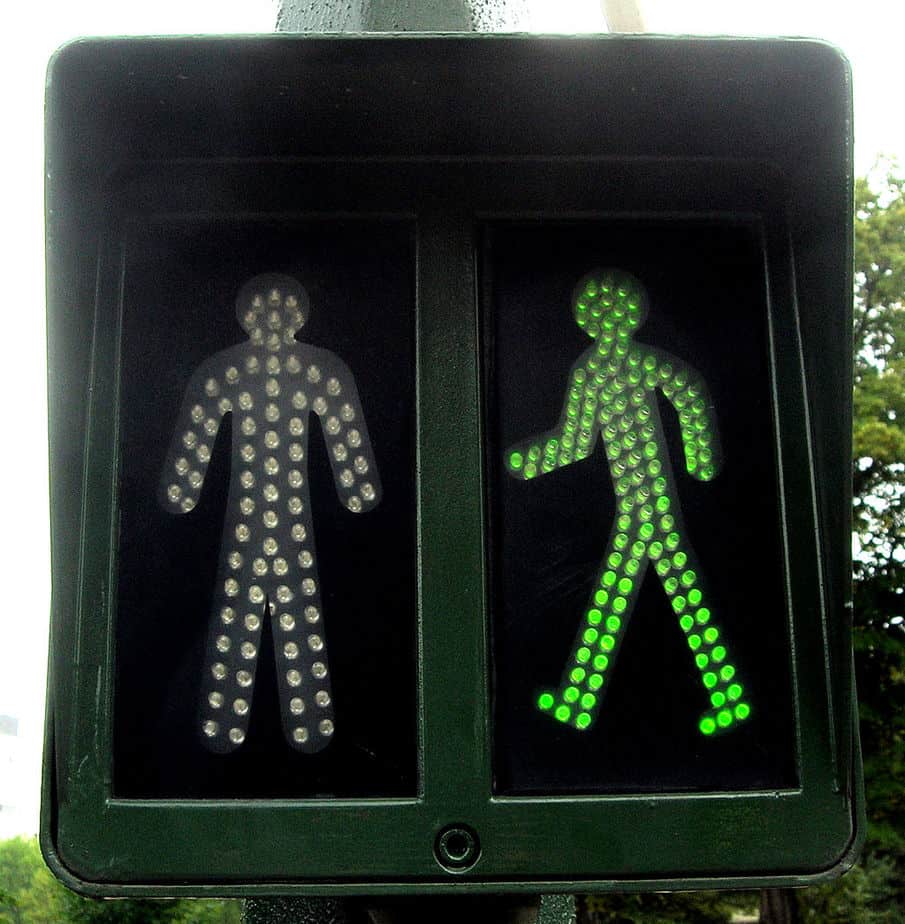Walking in Paris like a Parisian: advice and codes to respect
Updated by Vanessa M in August 2023.
As a traveler, one thing that always amazed me during my trips is how street behavior may be different from one place to another. Some towns are warm and welcoming, calm and peaceful, while others are bustling, stressful, somewhat aggressive.
For the non-Parisian, the French Capital is of the latter-kind. On your first encounter with them, as you venture out of your hotel, you might perceive Parisians as rude, aggressive and definitely not peaceful. This could be discussed endlessly, but I personally believe that Parisians suffer from the crowds overall.
Remember that Paris is one of the most overcrowded places on Earth. The city counts an average of 22,500 inhabitants per square kilometres, to which 34 million tourists add up each year. With 10 million people living in the close vicinity also frequently traveling into the city, the obvious overpopulation of the city – not designed for such crowds – helps understand the somewhat despicable reactions tourists often experience.
Since we, at Discoverwalks, wish you to enjoy your Parisian stay as much as possible, I gathered here a few rules you should try to follow in order to improve your street experience in Paris.
By ensuring you limit your disruption of Parisians everyday-lives (remember that they live here, are not on vacation, and may be in a rush, or having a rough day), you also minimize your chances of being heckled or yelled at, and you maximize your chances of making great pleasant encounters.
Believe me, Parisians may also be very nice if you abide by their code. Here are 5 tips for you:
1. Keep the flow going
Parisians will always appreciate things to go as smoothly as possible (this is what you get for living in an overpopulated area).
Leave space on the sidewalk
First, whenever possible, try to keep your right, just like on the road with your car. Remember that if you have all the time in the world to enjoy Paris, this may not be the case for everyone sharing your sidewalk.
You will notice that only a few people apply this principle in normal times become there is generally enough space for people crossing each other with no problem. However, whenever the situation gets tricky (a crowded sidewalk for instance), spontaneous reactions forming lanes usually occur. Single line formation everyone!
As a rule of thumb, avoid stopping in the middle of the sidewalk, and prefer moving to the right side. On very narrow sidewalks, you should avoid stopping there and walk until you find a wider area.
Never (ever) stop on the left side of an elevator
It is EXPECTED, from everyone, that whenever you take the escalators of the Metro, you stop on the right side. If you are on the left side, you are expected to walk and NOT stop. Once again, some people are in a rush, and they should be able to catch their train on time, without being held behind someone on the escalator. Really try to follow this principle, as breaking this rule will really raise your chances of receiving bad comments, and even insults from the locals.
Here are 5 things you need to know about Paris before planning your stay
2. Be careful with the direction you look to when you cross the road
In France, traffic runs on the right side of the road. Therefore, you must think that, when you cross the road, the best thing to do is to look to the left first, then to the right.
In Paris this is a good start (especially if your country drives on the left), however, this is not enough!
Indeed, for about a decade, the municipality has been working hard to reduce the number of cars and favour bikes. Bike lanes are slowly but surely popping up on every major – and non-major – streets. And this is when it gets tricky.
Some bike lanes are dual, and separate – which means they are separate from the car area but allow for both directions. These should be treated like a separate road and you should look both ways as you do for the cars.
Some bike lanes are separate from the main road with only one way each. Since these are narrower, they are more discreet and you should be careful not to wait ON the bike lane while you wait for crossing the road. This is dangerous.
3. Should you jaywalk?
What is jaywalking?
Jaywalking is the act of walking or crossing the road in a way that is not lawful.
In France, it is technically illegal to cross the road out of a crosswalk unless you are more than 50 meters away from the nearest one. I’ll be very clear: in Paris you must legally ALWAYS cross on a crosswalk, since all crosswalks will always be less than 50 meters away from you. It is also illegal to cross at the crosswalk if the pedestrian light is red. If you do any of these, you are jaywalking.
The law says that pedestrians always have the priority, the problem is, in France, it is not always the way it happens.
The Police are now quite careful that motor vehicles yield to pedestrians on crosswalks, and fines for not respecting this are quite high. In Paris however, many violations of this law can be observed, and you should be aware that it is not because the law says it, that it will happen, and you should remain careful.
In Paris, you will notice that jaywalking is very commonplace. To a Parisian, it will often seem ridiculous to wait for crossing on a small street with no traffic, just because the light is red.
If you come from a Roman culture (Italy, Spain, France, and most of Mediterranean Europe), jaywalking is something you do without even thinking it, because it is widely practiced, with almost no legal consequences.
In other cultures, especially the Germanic cultures (UK, Germany, Netherlands…) jaywalking can be considered very wrong. I remember being arrested in the USA for jaywalking, which seemed completely insane for me, at the time.
Should I do it?
Now, since it is not technically legal I will definitely not advise you to do it. However, should you wish to act “the Parisian way” anyway, you should not do it in an uncalculated way. Here are a few principles that even most Parisians wouldn’t dare breaching:
- NEVER ever attempt jaywalking on a major street or boulevard and respect lights on these boulevards.Never attempt this, you would only be risking your life (and the driver’s, since he would still be legally responsible for an accident).
- Triple check for cars AND BIKES, if you wish to jaywalk. Should any vehicle arrive, no matter how far you think it is, do not attempt crossing.
- Never fully rely on lights. Even if you cross at the green light, mind incoming vehicles, especially in narrow or turning streets with poor visibility. In Paris, it is safer to walk according to your own analysis of the situation.
- Legally, construction sites where pedestrian cannot safely use the sidewalk should always display a sign reading “piétons, traversée obligatoire” (pedestrians must cross the road). If the road is really busy, it is better to cross safely and take the other sidewalk, but otherwise, jaywalking is usually tolerated.
- Avoid jaywalking around kids – perhaps this is common sense, but set a good example.
Read more here on 10 Best Tips to Experience Paris Like a Local
4. Dress the part
I know, this one may sound presumptuous. Let me explain what I mean by that.
Your clothes and style define you to the world. It is the only thing that someone who doesn’t know you and sees you on the street can analyze from you. In Paris, Parisians are often tired of tourists. Entire buses of tourists storm the city center and the crowds can really become a nuisance.
If you want to avoid the automatic defiance that some Parisians may express towards visitors, your best bet is to blend in, and avoid screaming that you are a tourist.
Make sure you dress according to the Parisian codes, choose urban clothes (a pair of jeans, a t-shirt, and some urban sneakers is a great choice), rather than holiday clothes. Avoid shorts, sun hats, and visible cameras. Never get a paper map or guide out visibly – looking for your way on your smartphone is a much better option.
These seem like futile pieces of advice, but they really can help you being less noticeable. If you don’t do it to avoid bad looks and comments, do it at least for your safety, as pickpockets primarily target tourists.
5. Be respectful (in any way)
At first, this advice seems obvious. As grownups, you probably know very well that insulting or not being courteous will not get you far, and that, even if you think Parisians are rude, the wise thing to do is to remain courteous and respectful.
So, why do I insist on respect here?
Well, because without you even noticing, some of your actions may seem disrespectful or rude to Parisians. Sometimes, their reaction may even only be the results of your own actions! Now, I am not throwing rocks at you at all here.
Most of these actions badly perceived by the locals will result from your own culture clashing with the French way of doing things…
Here are some basics of French respect…
Equality is a core concept in France
If you come from a very traditional culture where a difference is still perceivable between men and women, you should be very careful with the way you act in France.
In France, women and men are considered equal – even if, in the facts, women still suffer from unfair mistreatments and financial gaps. Men should always make sure they treat women as their equal.
Any degrading comment would get a man seriously wrong looks and remarks from the locals – men and women alike – including if said comments were to be said in his own personal circle. Any unwanted physical contact, rude comment, insistent behaviour, would be considered harassment and is a punishable offense by law.
Don’t discriminate
Likewise, racism, xenophobia, homophobia and all sorts of discriminations are strictly prohibited in France. Even if they unfortunately still occur sometimes, it never makes them legal. So refrain from expressing these at all costs!
Parlez français
The French…speak French. The spreading habits of watching movies in original version now contributes to the younger generations understanding English much better, but it doesn’t mean that French is not their language.

The impressive façade of Institut de France, home to the French Academy, the main reference for French language – Picture by Doods Dumaguing – On Wikimedia Commons via Flickr
The French also take great pride in speaking French, which most consider to be one of the most beautiful languages in the World.
Whenever you have to interact with a French person, always try to start your conversation with a bit of French. It doesn’t have to be long or complex. You just need to explain to the person why you need to keep going in English.
For instance, you may say : « Bonjour, excusez-moi, je ne parle pas très bien français. Est-ce que cela vous dérange si je parle en anglais ? » (Hello, excuse me, I don’t speak French very well. Do you mind if I continue this conversation in English ?).
Why do I insist on this? Because by doing so, you put yourself in the real situation in which you are; that is, the position of a foreigner speaking respectfully to a local. Beginning a conversation immediately in English can be perceived as ignorant. It implies you expect they make efforts for you, without any of your own sacrifice.
Parisians will often continue in English if they see you are foreign, but this short introduction in French will get you a very long way.
Respect personal and intimate spaces
What I call “personal space” is the space around you and your friends or family. Technically, what happens between you must remain within this space, all the while understanding that a public space remains shared.
Be aware that, in public places, the French consider it rude to speak too loud.
You will notice in restaurants or in transports that people lower their voice a bit so that not everyone around has to listen to their conversation. It is expected that you do the same. In restaurants for instance, it would be considered rude to speak so loud that everyone could follow your conversation.
On the street, make sure you don’t overly occupy the space. The more you are in your group, the less spread you should be.
On the other hand, the “intimate space” for the French is roughly less than 1 meter wide, and is the space a person would considered minimum for an interaction with someone.
If you enter this space to talk, expect the person to step back or to clearly make you understand that you are too close, and that you are invading. Make sure you respect these distances whenever you are on the street, especially if you have to interact with someone, or ask for your direction.
I hope this little guide helps you better understand Parisians. As you could see the main issue throughout was clearly how the space is shared. As long as you keep this in mind, I promise that your Parisian experience will be good and memorable!
Even better: spending time with a Parisian would be a great intro to Parisian etiquette, so why not even book one or several of our guided tours? Click here to know more.
A brief history of Parisian Etiquette
Parisian etiquette was heavily impacted by courtly manners and chivalry during the Middle Ages and Renaissance. The tone for social interactions is established by nobility and royalty, who emphasize proper behavior, hierarchical structure, and the necessity of etiquette in maintaining order.
Parisian etiquette was refined throughout the 17th and 18th centuries. The court of King Louis XIV of France became a model for European nobility. The “Sun King” imposed strict standards of behavior on the upper tiers of Parisian society at Versailles.

F. W. Fairholt, Public domain, via Wikimedia Commons
During this period, the “Grandes Écoles,” or finishing schools, were established, where young nobles taught manners, dialogue, and social graces. The French Revolution resulted in the erosion of the aristocracy’s dominance in France during the nineteenth century.
With the emergence of the bourgeoisie came new etiquette norms focusing on refinement, elegance, and intellectualism. Parisian salons became centers for intellectual discourse, with attendees engaging in heated debates while maintaining a certain amount of decorum.
Here are 10 Things to Learn From Parisian Women
The Belle Époque was a time of cultural luxury and artistic expression in the late nineteenth and early twentieth centuries. Paris retained its position as a global cultural center, and etiquette at the time was defined by refinement, fashion, and aesthetic appreciation.

https://pixabay.com/photos/book-etiquette-manners-emily-post-2752591/
Café culture, artistic salons, and high society meetings were popular, necessitating participants’ knowledge of many genres of art and literature. Parisian etiquette today shows a blend of history and modern ideas. While some traditional norms still exist, Parisians are noted for their adaptability and open-mindedness.
The city values diversity and modern etiquette values respect, inclusion, and concern for others. Paris has assimilated international influences as a global metropolis, resulting in a more cosmopolitan and open attitude to manners.
5 Additional useful things to know about Parisian etiquette
Greetings and Farewells: In Paris depending on the time of day it is tradition to greet individuals with a polite “Bonjour” (Good morning) or “Bonsoir” (Good evening). Use “Au revoir” (Goodbye) or “Bonne journée/soirée” (Have a nice day/evening) while leaving. It is considered polite to address somebody with “Madame” or “Monsieur” followed by their last name.
Dining Etiquette: Wait for the host to begin the meal or announce that it is time to begin when dining. Keep your hands on the table but your wrists should rest on the edge. As soon as you’re seated place your napkin on your lap. It is considered polite to finish all of the food on your plate because wasting food is considered impolite.

https://pixabay.com/photos/fork-knife-spoon-dining-721679/
Personal Space and Volume: Parisians appreciate their personal space and are often more reserved in public. Speak quietly in public places such as cafes or on public transportation to avoid drawing unwanted attention. It’s also courteous to avoid using your phone loudly in public places.
Dress Code: Even in casual contexts, Parisians dress more stylishly and attentively. Avoid wearing clothing that is too casual or sloppy, especially when dining at finer restaurants or attending cultural events. It is preferable to be somewhat overdressed rather than underdressed.
Read more on Parisian Style: How to Dress Like a Parisian
Kissing on Cheeks: The French habit of “la bise” is to lightly kiss both cheeks as a greeting, usually among friends and acquaintances. The amount of kisses varies by region, however, two are common in Paris. Pay attention to cues to assess whether or not this is suitable, and always follow the locals’ lead.

Photo by Danik Prihodko from Pexels
Planning a trip to Paris ? Get ready !
These are Amazon’s best-selling travel products that you may need for coming to Paris.
Bookstore
- The best travel book : Rick Steves – Paris 2023 – Learn more here
- Fodor’s Paris 2024 – Learn more here
Travel Gear
- Venture Pal Lightweight Backpack – Learn more here
- Samsonite Winfield 2 28″ Luggage – Learn more here
- Swig Savvy’s Stainless Steel Insulated Water Bottle – Learn more here
Check Amazon’s best-seller list for the most popular travel accessories. We sometimes read this list just to find out what new travel products people are buying.

 English
English











